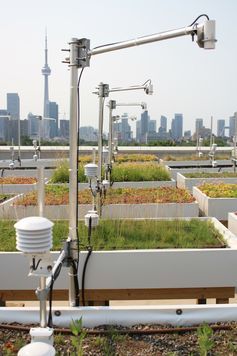Green Roofs for Stormwater Management
Published on by Water Network Research, Official research team of The Water Network in Academic
A new study showed that green roofs have the capacity to capture an average of 70 per cent of rainfall over a given time, relieving underground stormwater systems and releasing the rain water back into the atmosphere.

Image source: University of Toronto's GRIT Lab
The study was done by University of Toronto civil engineer Jenny Hill and co-researchers at the school’s Green Roof Innovation Testing Lab (GRIT Lab).
The study examined four green roof design variables that represent the most common industry practices: Planting type (succulents or grasses and herbaceous flowering plants), soil substitute (mineral, wood compost), planting depth (10 centimetres or 15 centimetres) and irrigation schedule (none, daily or sensor-activated), and how these four factors influenced water capture.
The watering schedule was shown to have the greatest effect, with retention capacity increasing from 50 per cent with daily irrigation to 70 per cent with sensor-activated or no irrigation. In other words, roofs that have not been watered, or are only watered when their soil reaches a predetermined moisture level, have a greater capacity to absorb stormwater.
Furthermore, the study calculated a new peak runoff coefficient — a constant value used to calculate the capacity of a green roof to hold water — for green roofs to be around 0.1-0.15, an 85 to 90 per cent reduction compared to an impermeable surface.
Designers and engineers routinely use a figure of 0.5 (50 per cent reduction) to assess green roof performance. This discrepancy between industry practice and regional evidence-based findings highlights the need for further research.
The second most significant variable for stormwater retention was the soil substitute. The most widely used green roof planting material is based on guidelines from the German Landscape Research, Development and Construction Society (FLL).
The FLL recommended a mineral aggregate because it’s thought to be longer-lasting and hardier than biological soil substitutes. But this recommendation has been challenged by research today.
Hill and her team compared the mineral growing material to wood compost. The compost outperformed the mineral by 10 per cent (70 per cent versus 60 per cent rainfall retained) in beds with no irrigation, and had minimal compression or break-down over time.
Another key finding in Hill’s study demonstrated that when already damp, either from watering or rain, the planting material had the biggest influence on water retention. The compost outperformed the mineral soil substitute by as much as three times when fully saturated (83 per cent rainfall retained versus 29 per cent).
Read full article: The Conversation
More from Gritlab
Media
Taxonomy
- Urban Agriculture
- Technology
- Integrated Urban Water Management
- Stormwater Management
- Stormwater
- Urban Water
- Urban Resource Management
- Storm Water Management
- Urban Water Infrastructure